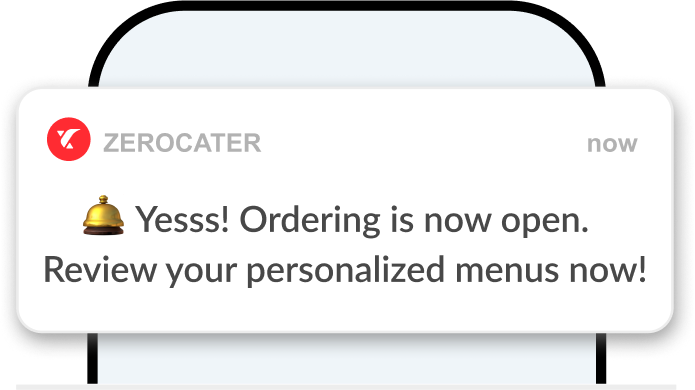That’s right. Lunch doesn’t have to be a time suck or an isolating occasion where employees eat solo at their desks. And you don’t have to wonder when your staff, after going off-site, will get back to work. One company found that snack and coffee runs alone accounted for 2.4 billion hours of lost productivity. Catered lunches improve productivity, workplace morale, employee health, and your bottom line.
Part of the ROI of corporate catering means cutting costs for employees
A typical American office worker spends an average of $3,000 a year on coffee and lunch during the work week. For an employee eating out, an average lunch costs $11, but that per-meal cost can be lower when an organization provides catered lunch.
Drive revenue through corporate catered lunches
You may also be able to save on your tax bill (discuss this with your tax professional first). When a business provides on-site food for its employees; unlike the 50 percent deduction for restaurant meals, that cost may be fully tax deductible*. Of course, some eligibility considerations apply for a full deduction, including:
- Meals must be provided on the business’s premises
- The meals must be available for all staff. Providing meals to select employees (such as management) could be only 50% deductible.
- Meals must be considered a perk or fringe benefit that’s part of employee compensation.
Your budget or circumstances may not currently allow you to cater an on-site meal five days a week, and that’s okay. Figure out a catering schedule such as every Friday or Monday, that works for your business and budget.
The gains? Employees stay in the office, which means they will likely engage more with one another. That can turn into not only improved morale and company culture, but higher productivity.

Corporate catering improves company culture
Everyone appreciates a free meal, and your employees are likely no different. Free lunch is a visible perk, and it’s a benefit you can offer at a lower cost compared to other benefits or perks. More importantly, it can increase employee happiness in the workplace (up to 30%, according to a WorkSphere survey) as well as contribute to a greater connection to the company. Typically, the more connected an employee feels to work, the more they are committed and productive.
Free catered lunch can also assist your recruiting efforts, especially among Millennials, the generation now comprising the largest part of America’s workforce since Baby Boomers. Quality snacks and lunches are important to Millennials, but it’s smart to expect anyone you interview to ask about your company’s food perks.
Work and success are about relationships, and sharing meals builds crucial interpersonal social ties. In a busy office, it can be hard for departments—or even employees in the same department—to communicate effectively and build stronger bonds. A catered lunch helps employees socialize, which leads to improved inter-department communication, say, between sales and marketing or IT and customer service. Not only does that deeper collaboration ease day-to-day headaches, it also incubates innovation, cooperation, and initiatives that build revenue and productivity.
Improved employee health is part of the catering ROI
Don’t want to think of it as lunch? Try thinking of catered meals as a core component of your company’s health and wellness program.
Absenteeism and working while sick contribute to $227 billion a year in lost productivity, part of an overall $576 billion annual health-related productivity loss. A Harvard study found that for each dollar a company spent on wellness programs, medical costs decreased $3.27. In practical terms, you cut your productivity losses when healthier employees miss less work due to illness, doctor visits, and medical procedures.
That doesn’t mean every catered lunch has to be a salad bar. It does mean, however, that you can balance your staff’s food preferences with healthy meals made with quality ingredients.
A good lunch at the office even has the potential to get an employee thinking more about their overall health and meal choices, which can lead to a healthier, happier, more productive worker.
Catering ROI shows itself in employee productivity
At the end of the day, though, office perks have to make up costs and bolster your bottom line. A catered lunch at the office can do just that.
Want your office to be more productive? Healthy meals can boost productivity 20 percent, says the International Labour Organization (ILO). Overall return on investment (ROI) for catered lunches can reach as high as 150 percent.
Catering ROI: Final thoughts
Instead of employees spending an hour (or more) away from the office, they could be on site, eating good food, engaging with one another, and discussing work issues and projects—all for the cost of lunch. Price out employee compensation over an hour for lunch, contrast that with what you may spend on a catered lunch, and examine the potential tax savings. The difference will likely surprise you—and show you a way to increase productivity, reduce costs, and bring improved innovation, performance, and revenue to your company. It’ll be time and money well spent—all for the price of lunch.
 to plan your catering
to plan your catering

